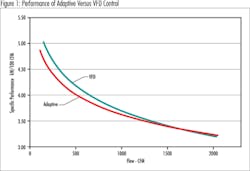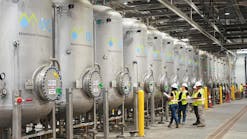The efficiency gains can be seen by examining each unit’s specific power and the combination of the units in service over the entire operating range of the system. Specific power is a ratio of total input power (KW at the input to the unit’s control system) over the produced flow rate (CFM). In low pressure air systems this is usually given as kW/100 CFM.
It is very important to consider the input kW to the control panel including all losses, not just the efficiency of the airend or the estimated power at the motor at a given design point. On VFD driven machines, input kW will vary over the entire operating range of the machine. At constant pressure, the efficiencies will drop at the lower end of the operating range; not only because of the lower airend efficiencies, but because of the losses in the motor and drives. An adaptive system will minimize running the VFDs in their low efficiency ranges.
As an example, consider a 2,000 CFM system at 7.0 PSIG (assuming standard conditions). A typical specification may require four liked sized machines with one of these being a full time backup. For the conventional setup, the units are to be sized for at least 666 CFM at 7.0 PSIG which results in a 30 hp blower. The combined average specific power of three units in operation will be 4.26 kW/100 CFM over the entire operating range of the system.
The adaptive control concept would use one 30 hp VFD driven blower package, three 20 hp mid-load fixed speed machines, and one 40 hp base-load fixed speed machine. Redundancy and backup is built into the system. The average specific performance of this system over the entire operating range is 3.68 kW/100 CFM.
Figure 1 shows a comparison of the specific power of the two systems assuming constant pressure and variable flow. At full flow, the VFD solution is essentially the same as the adaptive control. However, at lower flows the adaptive control system shows greater efficiency. If the entire performance envelope is averaged, the adaptive control system is 13% better than the VFD-only solution. Over a 10-year period, this equates to $95,000 in savings (based on 8.3 cents/kWh).
While this is an example of a small system that only considers average wire-to-air specific power for two control strategies, the potential for large savings is clear. Furthermore, many plants are sized with provision for community growth. The specified low pressure air system capacity may be much more than what is actually required. With this consideration, the plant may not see full flow conditions for many years to come, which will only further increase the operational savings provided by a high efficiency low pressure air system.
Because only one blower uses a VFD and the other blowers use dependable, reduced current starters the overall system reliability is improved. Auto-dual control (load/unload as well as on/off) for each constant speed blower provides for very close control of the flow and minimizes the number of starts per hour on the blower drive motors.
Modern wastewater treatment technology controls three cycles: DO, NH4, and NO3 in each basin individually using flow regulation valves. The process control PLC computes a variable target pressure for the blower station (i.e.; flow pressure control). The low pressure air system adaptive control receives the target pressure information and controls the individual blowers to provide maximum efficiency over a wide turn-down range (because turning blowers off is more efficient than reducing the frequency of multiple blower motor power supplies). Combined with lower initial cost, lower cost for redundancy, and greater reliability this control scheme is very appropriate for wastewater treatment plants with sophisticated automation.
WW
About the Author: Stephen Horne is U.S. Product Manager for Kaeser Compressors’ Omega Blower line. He has over 10 years’ experience with the design and function of blower systems in wastewater aeration applications. Horne serves as Kaeser’s in-house engineer for machine modifications and system design, and he is a primary blower product and application instructor in the company’s factory certified training program. He may be contacted at [email protected].
More WaterWorld Current Issue Articles
More WaterWorld Archives Issue Articles



